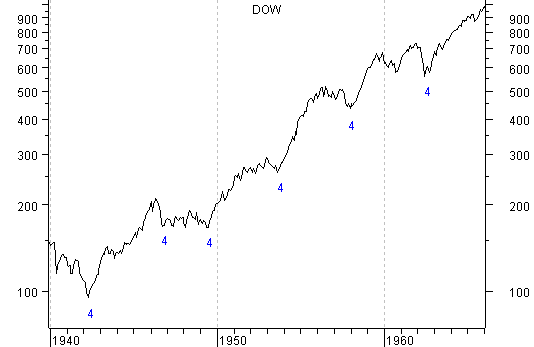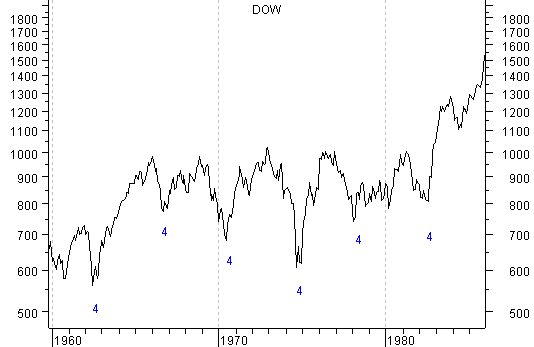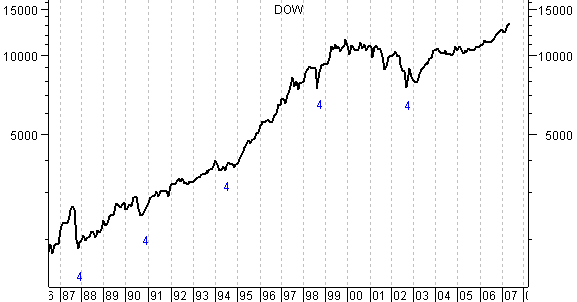More Questions On the 4-Year Stock Market Cycle That Refuses To Be
Stock-Markets / Cycles Analysis May 08, 2007 - 07:09 PM GMTBy: Tim_Wood
 Where's the 4-year cycle low? Did it bottom last summer? Could it have bottomed this past March? What would it mean if the Dow goes to 15,000? Hasn't this advance proven that cycles are no longer relevant? Doesn't it appear that history is no longer relevant? I continue receiving e-mail on these questions and in today's WrapUp I want to address these topics.
Where's the 4-year cycle low? Did it bottom last summer? Could it have bottomed this past March? What would it mean if the Dow goes to 15,000? Hasn't this advance proven that cycles are no longer relevant? Doesn't it appear that history is no longer relevant? I continue receiving e-mail on these questions and in today's WrapUp I want to address these topics.
Let's first begin with another explanation of cycles. Cycles are a part of everyday life. Our breathing and heartbeat are cycles. The changing of the seasons from summer, to fall, to winter and then to spring is a cycle. The phasing of the moon, the daily tidal changes of the sea and bird migration are all examples of cycles. There are cycles that are somewhat fixed in nature and then there are cycles that are more flexible in nature. For example, the cycle of the moon is pretty much fixed in that we have a full moon every 29 days. But, the changing of the seasons and the migration of geese may vary.
Just because there may be snow on the ground in late April doesn't mean that spring isn't coming. When we are dealing with a cycle that is only a few days long, then the normal variation or fluctuation will obviously be much less than in the case of an annual cycle like the changing of the seasons or the migration pattern of birds, which could vary for weeks. When we with are dealing very long cycles such as the ice ages, the cycle can vary thousands of years. Nonetheless, cycles still exist as do the fluctuations or variations of these cycles, and these variations are proportional to the duration of the cycle.
Cycles in the stock market are not fixed like the cycle of the moon. Cycle analysis in the stock market is really nothing more than a method of quantifying a given trend of a given duration. There are very short-term cycles, intermediate-term cycles, long and even very long-term cycles in the stock market. I have once again included charts below showing each of the long-term 4-year cycles in the Industrials going back to its inception in 1896.





When there is a cyclical rhythm that varies, scientists use statistical analysis and averages to gauge the expectation of future cycles. In the case of the stock market we can apply the same approach. Since 1896 there have been 27 completed 4-year cycles. The average duration of these 27 cycles has been 47 months. Of these 27 cycles, 13 have extended beyond 47 months. This makes sense in that half of the cycles have extended beyond the 47 month average and half have been shorter. Now I want to look at the 13 cycles that have run longer than the 47 month average. In doing so I find that the average duration of these cycles has been 54 months. Furthermore, there have only been 5 cycles that have run 55 months or longer. From the October 2002 4-year cycle low to May 2007 is 55 months. With only 18% of the previous 27 4-year cycles having run this long, yes, we are presently dealing with an unusually long cycle.
In addition to these statistical norms on the 4-year cycle, I have a number of very specific “markers” that are used to identify 4-year cycle lows. In fact, these markers have been present at every 4-year cycle low since 1896. One of the many important aspects of these markers is that they tell me when the 4-year cycle has topped and when the 4-year cycle has bottomed. So, there are two distinctly different pieces of data here. One gives us the statistics on the phasing of the 4-year cycle and the other is the “markers” that actually indicate, or have in the past 110 years, indicated 4-year cycle tops and bottoms.
The statistical data has been telling us for a while now that the 4-year cycle top has been due. But, none of the markers of either a 4-year cycle top or bottom have occurred. In other words, the markers used to identify 4-year cycle tops and bottoms have remained positive as the market has continued pushing the statistical envelope. So, on one hand we have had and still have the statistics telling us that a top is due, all the while, the indicators have remained positive telling us that higher prices were and still are possible as this cycle continues to stretch further and further. So, if we have not seen the historical markers that have occurred at previous 4-year cycle lows and if all of the longer-term indicators remain positive, plus the statistics continue to tell us that a low has not been seen, then the most logical conclusion is that the 4-year cycle is stretching.
In addition to these long term statistics and indicators, I also use my intermediate-term Cycle Turn Indicator as my primary market tool. In my April 1st newsletter I wrote “ The intermediate-term Cycle Turn Indicator is our cornerstone indicator and this is by far the most important tool we have. Those of you who have been following this indicator over the last year or so surely have learned the importance of this tool. I know I certainly have. Let me also stress that above and beyond ALL other analysis in this newsletter, the single most important tool we have is the weekly Cycle Turn Indicator and the bottom line is that all we have to do is follow it. Everything else is secondary .
Stocks: At present, the weekly/intermediate-term Cycle Turn Indicator is positive and we have a weekly swing low in place on most major averages. This in turn triggered intermediate-term buy signals on most major market averages the week of March 23rd. ” As of this writing, the intermediate-term buy signal that was triggered the week of March 23, 2007 also remains intact.
Now, I say all of the above to make one point. I have been asked if I was ready to concede that the 4-year cycle low has occurred. Anyone that asks this question does not understand the nature of the statistical data of what I have been saying. This is not a concede-able point in that the data is black and white. Either the historical markers that have been seen at every other 4-year cycle low over the last 110 years has occurred or it hasn't. In this case it hasn't, and there is no middle ground or anything to concede on. The markers simply have not been seen. Yet, the indicators have been positive and remain positive today. So, yes, we could still see higher prices. But, it doesn't matter if the Industrials advance straight to 15,000 from here, the historical markers that have occurred at all previous 4-year cycle lows still have not been seen since the 2002 low. Furthermore, we have not seen any of the markers of 4-year cycle tops since the 2000 top.
This simply means one of two things. Either the 4-year cycle that bottomed in 2002 is being stretched by the sea of liquidity and hedge fund activity, or the 4-year cycle low did occur and in doing so none of these historical markers were seen. It's that simple.
Now, I do realize that there is a first time for everything. But, I look at numbers and data from which I base my opinion. The bottom line is that the data tells me that we are likely dealing with a very stretched 4-year cycle advance. If the market made a 4-year cycle low and has begun a new cycle up, then we would have also had to have made a 4-year cycle top prior to that low. In which case, we would have both a 4-year cycle top and bottom of which neither were made in conjunction with the historical markers of the last 110 years. The data simply does not support this. It tells me that the 4-year cycle advance that began in 2002 is still intact.
In light of the data surrounding the 4-year cycle, the saving grace that I have had for myself and my subscribers has been the intermediate-term Cycle Turn Indicator. I keep one eye on these longer-term statistics because they are very important and they continue to concern me, but I always follow the direction of my intermediate-term Cycle Turn Indicator, which last turned positive the week of March 23, 2007.
By Tim Wood
Cyclesman.com
© 2007 Cycles News & Views; All Rights Reserved
Tim Wood specialises in Dow Theory and Cycles Analysis - Should you be interested in analysis that provides intermediate-term turn points utilizing the Cycle Turn Indicator as well as coverage on the Dow theory, other price quantification methods and all the statistical data surrounding the 4-year cycle, then please visit www.cyclesman.com for more details. A subscription includes access to the monthly issues of Cycles News & Views covering the stock market, the dollar, bonds and gold. I also cover other areas of interest at important turn points such as gasoline, oil, silver, the XAU and recently I have even covered corn. I also provide updates 3 times a week plus additional weekend updates on the Cycle Turn Indicator on most all areas of concern. I also give specific expectations for turn points of the short, intermediate and longer-term cycles based on historical quantification.
© 2005-2022 http://www.MarketOracle.co.uk - The Market Oracle is a FREE Daily Financial Markets Analysis & Forecasting online publication.
Comments
|
Jo
09 May 07, 00:50 |
Theres articles dating back months about this cycle low ? where is it ? Maybe your wrong ? |


